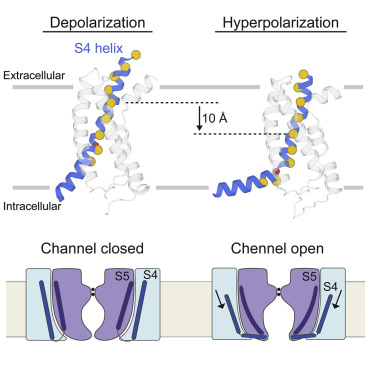Our official English website, www.x-mol.net, welcomes your feedback! (Note: you will need to create a separate account there.)
Voltage Sensor Movements during Hyperpolarization in the HCN Channel.
Cell ( IF 64.5 ) Pub Date : 2019-11-28 , DOI: 10.1016/j.cell.2019.11.006 Chia-Hsueh Lee 1 , Roderick MacKinnon 1
Cell ( IF 64.5 ) Pub Date : 2019-11-28 , DOI: 10.1016/j.cell.2019.11.006 Chia-Hsueh Lee 1 , Roderick MacKinnon 1
Affiliation

|
The hyperpolarization-activated cyclic nucleotide-gated (HCN) channel is a voltage-gated cation channel that mediates neuronal and cardiac pacemaker activity. The HCN channel exhibits reversed voltage dependence, meaning it closes with depolarization and opens with hyperpolarization. Different from Na+, Ca2+, and Kv1-Kv7 channels, the HCN channel does not have domain-swapped voltage sensors. We introduced a reversible, metal-mediated cross bridge into the voltage sensors to create the chemical equivalent of a hyperpolarized conformation and determined the structure using cryoelectron microscopy (cryo-EM). Unlike the depolarized HCN channel, the S4 helix is displaced toward the cytoplasm by two helical turns. Near the cytoplasm, the S4 helix breaks into two helices, one running parallel to the membrane surface, analogous to the S4-S5 linker of domain-swapped voltage-gated channels. These findings suggest a basis for allosteric communication between voltage sensors and the gate in this kind of channel. They also imply that voltage sensor movements are not the same in all voltage-gated channels.
中文翻译:

HCN通道中超极化过程中的电压传感器运动。
超极化激活的环状核苷酸门控(HCN)通道是介导神经元和心脏起搏器活动的电压门控阳离子通道。HCN通道表现出反向的电压依赖性,这意味着它在去极化时关闭,而在超极化时打开。与Na +,Ca2 +和Kv1-Kv7通道不同,HCN通道没有域交换电压传感器。我们在电压传感器中引入了可逆的,金属介导的交叉桥,以产生超极化构象的化学等效物,并使用低温电子显微镜(cryo-EM)确定了结构。与去极化的HCN通道不同,S4螺旋向螺旋移动了两个螺旋圈。在细胞质附近,S4螺旋分裂成两个螺旋,一个平行于膜表面,类似于域交换电压门控通道的S4-S5链接器。这些发现为这种通道中的电压传感器和栅极之间的变构通信提供了基础。它们还暗示电压传感器在所有电压门控通道中的移动都不相同。
更新日期:2019-11-29
中文翻译:

HCN通道中超极化过程中的电压传感器运动。
超极化激活的环状核苷酸门控(HCN)通道是介导神经元和心脏起搏器活动的电压门控阳离子通道。HCN通道表现出反向的电压依赖性,这意味着它在去极化时关闭,而在超极化时打开。与Na +,Ca2 +和Kv1-Kv7通道不同,HCN通道没有域交换电压传感器。我们在电压传感器中引入了可逆的,金属介导的交叉桥,以产生超极化构象的化学等效物,并使用低温电子显微镜(cryo-EM)确定了结构。与去极化的HCN通道不同,S4螺旋向螺旋移动了两个螺旋圈。在细胞质附近,S4螺旋分裂成两个螺旋,一个平行于膜表面,类似于域交换电压门控通道的S4-S5链接器。这些发现为这种通道中的电压传感器和栅极之间的变构通信提供了基础。它们还暗示电压传感器在所有电压门控通道中的移动都不相同。



























 京公网安备 11010802027423号
京公网安备 11010802027423号